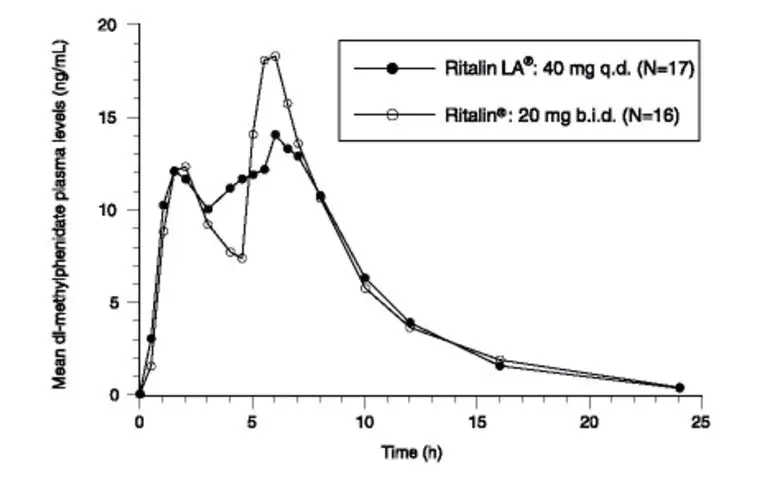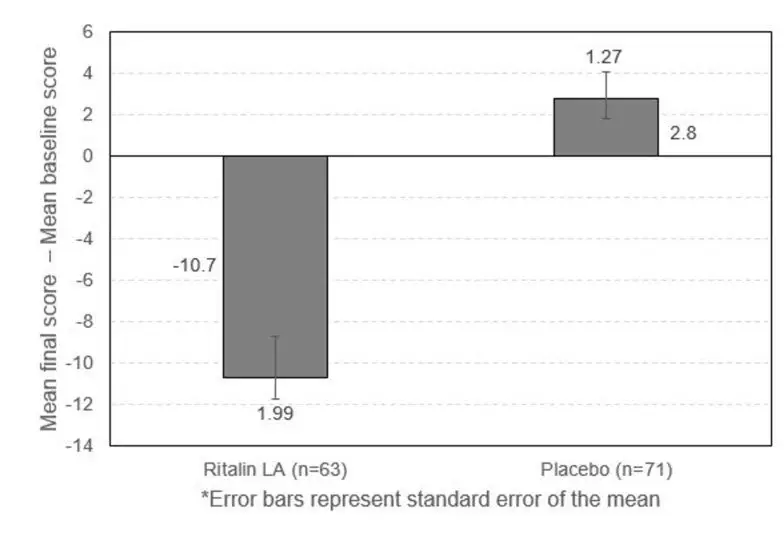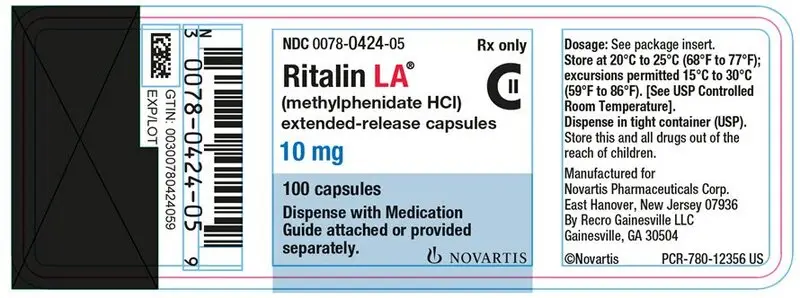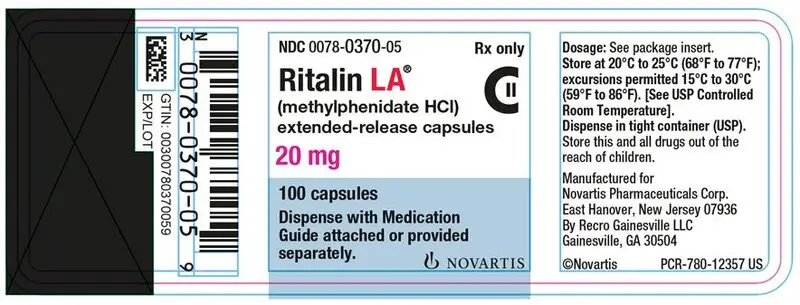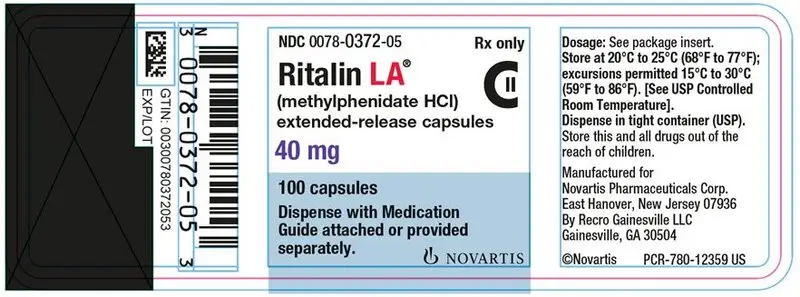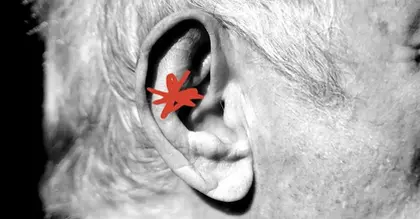Drug Detail:Ritalin la (Methylphenidate (oral) [ meth-il-fen-i-date ])
Drug Class: CNS stimulants
Highlights of Prescribing Information
RITALIN LA® (methylphenidate hydrochloride) extended-release capsules for oral use, CII
Initial U.S. Approval: 1955
WARNING: ABUSE AND DEPENDENCE
See full prescribing information for complete boxed warning.
- CNS stimulants, including Ritalin LA, other methylphenidate-containing products, and amphetamines, have a high potential for abuse and dependence. (5.1, 9.2, 9.3)
- Assess the risk of abuse prior to prescribing, and monitor for signs of abuse and dependence while on therapy. (5.1, 9.2)
Indications and Usage for Ritalin LA
Ritalin LA is a central nervous system (CNS) stimulant indicated for the treatment of Attention Deficit Hyperactivity Disorder (ADHD) in pediatric patients 6 to 12 years of age. (1)
Ritalin LA Dosage and Administration
- Administer orally once daily in the morning. (2.2)
- Capsules may be swallowed whole, or opened and the entire contents sprinkled on applesauce. (2.2)
- Should not be crushed, chewed, or divided. (2.2)
- Patients new to methylphenidate: Start at 20 mg daily, titrating the dose weekly in 10-mg increments. Doses above 60 mg daily are not recommended. (2.3)
- For patients currently using Ritalin or Ritalin-SR: Dosage is based on current dose regimen. (2.4)
- If switching from other methylphenidate products, discontinue treatment and titrate with Ritalin LA. (2.4)
Dosage Forms and Strengths
Extended-release capsules: 10 mg, 20 mg, 30 mg, and 40 mg. (3)
Contraindications
- Known hypersensitivity to methylphenidate or product components. (4)
- Concurrent treatment with a monoamine oxidase inhibitor (MAOI), or use of an MAOI within the preceding 14 days. (4)
Warnings and Precautions
- Serious Cardiovascular Events: Sudden death has been reported in association with CNS-stimulant treatment at usual doses in pediatric patients with structural cardiac abnormalities or other serious heart problems. In adults, sudden death, stroke, and myocardial infarction have been reported. Avoid use in patients with known structural cardiac abnormalities, cardiomyopathy, serious heart rhythm arrhythmias, or coronary artery disease. (5.2)
- Blood Pressure and Heart Rate Increases: Monitor blood pressure and pulse. Consider the benefits and risk in patients for whom an increase in blood pressure or heart rate would be problematic. (5.3)
- Psychiatric Adverse Reactions: Use of stimulants may cause psychotic or manic symptoms in patients with no prior history or exacerbation of symptoms in patients with preexisting psychiatric illness. Evaluate for preexisting psychotic or bipolar disorder prior to Ritalin LA use. (5.4)
- Priapism: Cases of painful and prolonged penile erections, and priapism have been reported with methylphenidate products. Immediate medical attention should be sought if signs or symptoms of prolonged penile erections or priapism are observed. (5.5)
- Peripheral Vasculopathy, Including Raynaud’s Phenomenon: Stimulants used to treat ADHD are associated with peripheral vasculopathy, including Raynaud’s phenomenon. Careful observation for digital changes is necessary during treatment with ADHD stimulants. (5.6)
- Long-Term Suppression of Growth: Monitor height and weight at appropriate intervals in pediatric patients. (5.7)
Adverse Reactions/Side Effects
Most common adverse reactions (greater than 5% during incidence) were headache, insomnia, upper abdominal pain, decreased appetite, and anorexia. (6)
To report SUSPECTED ADVERSE REACTIONS, contact Novartis Pharmaceuticals Corporation at 1-888-669-6682 or FDA at 1-800-FDA-1088 or www.fda.gov/medwatch.
Drug Interactions
- Antihypertensive Drugs: Monitor blood pressure and heart. Adjust dosage of antihypertensive drug as needed. (7.1)
- Halogenated Anesthetics: Avoid use of Ritalin LA on the day of surgery if halogenated anesthetics will be used. (7.1)
See 17 for PATIENT COUNSELING INFORMATION and Medication Guide.
Revised: 6/2021
Full Prescribing Information
1. Indications and Usage for Ritalin LA
Ritalin LA® is indicated for the treatment of Attention Deficit Hyperactivity Disorder (ADHD), in pediatric patients 6 to 12 years of age [see Clinical Studies (14)].
2. Ritalin LA Dosage and Administration
2.1 Pretreatment Screening
Prior to initiating treatment with central nervous system (CNS) stimulants, including Ritalin LA, assess for the presence of cardiac disease (i.e., perform a careful history, including family history of sudden death or ventricular arrhythmia, and physical examination) [see Warnings and Precautions (5.2)].
Assess the risk of abuse prior to prescribing, and monitor for signs of abuse and dependence while on therapy. Maintain careful prescription records, educate patients about abuse, monitor for signs of abuse and overdose, and periodically reevaluate the need for Ritalin LA use [see Boxed Warning, Warnings and Precautions (5.1), Drug Abuse and Dependence (9.2, 9.3)].
2.2 General Dosing Information
The recommended starting dose for Ritalin LA is 20 mg once daily. Increase dosage gradually, in increments of 10 mg weekly. Daily dosage above 60 mg is not recommended. When a lower initial dose is appropriate, patients may begin treatment with 10 mg.
Administer Ritalin LA orally once daily in the morning. Ritalin LA may be swallowed as whole capsules or may be administered by sprinkling the capsule contents on a small amount of applesauce (see specific instructions below). Ritalin LA and/or their contents should not be crushed, chewed, or divided.
The capsules may be carefully opened and the beads sprinkled over a spoonful of applesauce. The applesauce should not be warm because it could affect the modified release properties of this formulation. The mixture of drug and applesauce should be consumed immediately in its entirety. The drug and applesauce mixture should not be stored for future use.
Pharmacological treatment of ADHD may be needed for extended periods. Periodically reevaluate the long-term use of Ritalin and Ritalin-SR, and adjust dosage as needed.
2.3 Patients Currently Using Ritalin or Ritalin-SR
The recommended dose of Ritalin LA for patients currently taking Ritalin twice daily or Ritalin extended-release (SR) is provided below.
| Previous Ritalin or Ritalin-SR Dose | Recommended Ritalin LA Dose |
| 5 mg Ritalin twice daily | 10 mg once daily |
| 10 mg Ritalin twice daily or 20 mg Ritalin-SR | 20 mg once daily |
| 15 mg Ritalin twice daily | 30 mg once daily |
| 20 mg Ritalin twice daily or 40 mg Ritalin-SR | 40 mg once daily |
| 30 mg Ritalin twice daily or 60 mg Ritalin-SR | 60 mg once daily |
2.4 Switching From Other Methylphenidate Products
If switching from other methylphenidate products, discontinue that treatment, and titrate with Ritalin LA using the titration schedule.
Do not substitute for other methylphenidate products on a milligram-per-milligram basis, because different methylphenidate base compositions and differing pharmacokinetic profiles [see Description (11), Clinical Pharmacology (12.3)].
Clinical judgment should be used when selecting the starting dose. Daily dosage above 60 mg is not recommended.
3. Dosage Forms and Strengths
- 10 mg extended-release capsules white/light brown, (imprinted "NVR R10")
- 20 mg extended-release capsules white, (imprinted "NVR R20")
- 30 mg extended-release capsules yellow, (imprinted "NVR R30")
- 40 mg extended-release capsules light brown, (imprinted "NVR R40")
4. Contraindications
- Hypersensitivity to methylphenidate or other components of Ritalin LA. Hypersensitivity reactions, such as angioedema and anaphylactic reactions, have been reported in patients treated with methylphenidate [see Adverse Reactions (6.1)].
- Concomitant treatment with monoamine oxidase inhibitors (MAOIs), or within 14 days following discontinuation of treatment with an MAOI, because of the risk of hypertensive crises [see Drug Interactions (7.1)].
5. Warnings and Precautions
5.1 Potential for Abuse and Dependence
CNS stimulants, including Ritalin LA, other methylphenidate-containing products, and amphetamines, have a high potential for abuse and dependence. Assess the risk of abuse prior to prescribing, and monitor for signs of abuse and dependence while on therapy [see Boxed Warning, Drug Abuse and Dependence (9.2, 9.3)].
5.2 Serious Cardiovascular Reactions
Sudden death, stroke, and myocardial infarction have been reported in adults with CNS-stimulant treatment at recommended doses. Sudden death has been reported in pediatric patients with structural cardiac abnormalities and other serious heart problems taking CNS stimulants at recommended doses for ADHD. Avoid use in patients with known structural cardiac abnormalities, cardiomyopathy, serious heart rhythm abnormalities, coronary artery disease, and other serious heart problems. Further evaluate patients who develop exertional chest pain, unexplained syncope, or arrhythmias during Ritalin LA treatment.
5.3 Blood Pressure and Heart Rate Increases
CNS stimulants cause an increase in blood pressure (mean increase approximately 2 to 4 mmHg) and heart rate (mean increase approximately 3 to 6 beats per minute). Individuals may have larger increases. Monitor all patients for hypertension and tachycardia.
5.4 Psychiatric Adverse Reactions
Exacerbation of Preexisting Psychosis
CNS stimulants may exacerbate symptoms of behavior disturbance and thought disorder in patients with a preexisting psychotic disorder.
Induction of a Manic Episode in Patients with Bipolar Disorder
CNS stimulants may induce a manic or mixed mood episode in patients. Prior to initiating treatment, screen patients for risk factors for developing a manic episode (e.g., comorbid or history of depressive symptoms or a family history of suicide, bipolar disorder, or depression).
New Psychotic or Manic Symptoms
CNS stimulants, at recommended doses, may cause psychotic or manic symptoms (e.g., hallucinations, delusional thinking, or mania) in patients without a prior history of psychotic illness or mania. If such symptoms occur, consider discontinuing Ritalin LA. In a pooled analysis of multiple short-term, placebo-controlled studies of CNS stimulants, psychotic or manic symptoms occurred in approximately 0.1% of CNS stimulant-treated patients, compared to 0 in placebo-treated patients.
5.5 Priapism
Prolonged and painful erections, sometimes requiring surgical intervention, have been reported with methylphenidate products in both pediatric and adult patients. Priapism was not reported with drug initiation but developed after some time on the drug, often subsequent to an increase in dose. Priapism has also appeared during a period of drug withdrawal (drug holidays or during discontinuation). Patients who develop abnormally sustained or frequent and painful erections should seek immediate medical attention.
5.6 Peripheral Vasculopathy, Including Raynaud’s Phenomenon
CNS stimulants, including Ritalin LA, used to treat ADHD are associated with peripheral vasculopathy, including Raynaud’s phenomenon. Signs and symptoms are usually intermittent and mild; however, very rare sequelae include digital ulceration and/or soft tissue breakdown. Effects of peripheral vasculopathy, including Raynaud’s phenomenon, were observed in post-marketing reports at different times and at therapeutic doses in all age groups throughout the course of treatment. Signs and symptoms generally improve after reduction in dose or discontinuation of drug. Careful observation for digital changes is necessary during treatment with ADHD stimulants. Further clinical evaluation (e.g., rheumatology referral) may be appropriate for certain patients.
5.7 Long-Term Suppression of Growth
CNS stimulants have been associated with weight loss and slowing of growth rate in pediatric patients.
Careful follow-up of weight and height in pediatric patients ages 7 to 10 years who were randomized to either methylphenidate or non-medication treatment groups over 14 months, as well as in naturalistic subgroups of newly methylphenidate-treated and non-medication treated patients over 36 months (to the ages of 10-13 years), suggests that consistently medicated pediatric patients (i.e., treatment for 7 days per week throughout the year) have a temporary slowing in growth rate (on average, a total of about 2 cm less growth in height and 2.7 kg less growth in weight over 3 years), without evidence of growth rebound during this period of development.
Closely monitor growth (weight and height) in pediatric patients treated with CNS stimulants, including Ritalin LA. Patients who are not growing or gaining height or weight as expected may need to have their treatment interrupted.
6. Adverse Reactions/Side Effects
The following are discussed in more detail in other sections of the labeling:
- Abuse and Dependence [see Boxed Warning, Warnings and Precautions (5.1), Drug Abuse and Dependence (9.2, 9.3)]
- Known hypersensitivity to methylphenidate or other ingredients of Ritalin LA [see Contraindications (4)]
- Hypertensive crisis when used concomitantly with Monoamine Oxidase Inhibitors [see Contraindications (4), Drug Interactions (7.1)]
- Serious Cardiovascular Reactions [see Warnings and Precautions (5.2)]
- Blood Pressure and Heart Rate Increases [see Warnings and Precautions (5.3)]
- Psychiatric Adverse Reactions [see Warnings and Precautions (5.4)]
- Priapism [see Warnings and Precautions (5.5)]
- Peripheral Vasculopathy, Including Raynaud’s Phenomenon [see Warnings and Precautions (5.6)]
- Long-Term Suppression of Growth [see Warnings and Precautions (5.7)]
6.1 Clinical Trials Experience
Because clinical trials are conducted under widely varying conditions, adverse reaction rates observed in the clinical trials of a drug cannot be directly compared to rates in the clinical trials of another drug and may not reflect the rates observed in practice.
The clinical program for Ritalin LA consisted of 6 studies: 2 controlled clinical studies conducted in children with ADHD aged 6 to 12 years and 4 clinical pharmacology studies conducted in healthy adult volunteers. These studies included a total of 256 subjects; 195 children with ADHD and 61 healthy adult volunteers. The subjects received Ritalin LA in doses of 10 to 40 mg per day. Safety of Ritalin LA was assessed by evaluating frequency and nature of adverse events, routine laboratory tests, vital signs, and body weight. A placebo-controlled, double-blind, parallel-group study was conducted to evaluate the efficacy and safety of Ritalin LA in children with ADHD aged 6 to 12 years. All subjects received Ritalin LA for up to 4 weeks, and had their dose optimally adjusted, prior to entering the double-blind phase of the trial. In the 2-week double-blind treatment phase of this study, patients received either placebo or Ritalin LA at their individually-titrated dose (range, 10 to 40 mg).
Adverse reactions with an incidence greater than 5% during the initial 4-week single-blind Ritalin LA titration period of this study were headache, insomnia, upper abdominal pain, appetite decreased, and anorexia.
Adverse reactions with an incidence greater than 2% among Ritalin LA-treated subjects, during the 2-week double-blind phase of the clinical study, are shown in Table 2.
| Preferred Term | Ritalin LA N = 65 N (%) | Placebo N = 71 N (%) |
| Anorexia | 2 (3.1) | 0 (0.0) |
| Insomnia | 2 (3.1) | 0 (0.0) |
Adverse Events Associated With Discontinuation of Treatment
In the 2-week double-blind treatment phase of a placebo-controlled parallel-group study in children with ADHD, one Ritalin LA-treated subject (1/65, 1.5%) discontinued due to an adverse event (depressed mood).
In the single-blind titration period of this study, subjects received Ritalin LA for up to 4 weeks. During this period a total of 6 subjects (6/161, 3.7%) discontinued due to adverse events. The adverse events leading to discontinuation were anger (2 patients), hypomania, anxiety, depressed mood, fatigue, migraine, and lethargy.
6.2 Postmarketing Experience
The following adverse reactions have been identified during the post approval use of methylphenidate products. Because these reactions were reported voluntarily from a population of uncertain size, it is not always possible to estimate their frequency reliably or to establish a causal relationship to drug exposure.
Adverse Reactions Reported With Ritalin, Ritalin-SR, and Ritalin LA
Infections and Infestations: nasopharyngitis
Blood and the Lymphatic System Disorders: leukopenia, thrombocytopenia, anemia
Immune System Disorders: hypersensitivity reactions, including angioedema and anaphylaxis
Metabolism and Nutrition Disorders: decreased appetite, reduced weight gain, and suppression of growth during prolonged use in children
Psychiatric Disorders: insomnia, anxiety, restlessness, agitation, psychosis (sometimes with visual and tactile hallucinations), depressed mood
Nervous System Disorders: headache, dizziness, tremor, dyskinesia, including choreoathetoid movements, drowsiness, convulsions, cerebrovascular disorders (including vasculitis, cerebral hemorrhages and cerebrovascular accidents), serotonin syndrome in combination with serotonergic drugs
Eye Disorders: blurred vision, difficulties in visual accommodation
Cardiac Disorders: tachycardia, palpitations, increased blood pressure, arrhythmias, angina pectoris
Respiratory, Thoracic, and Mediastinal Disorders: cough
Gastrointestinal Disorders: dry mouth, nausea, vomiting, abdominal pain, dyspepsia
Hepatobiliary Disorders: abnormal liver function, ranging from transaminase elevation to severe hepatic injury
Skin and Subcutaneous Tissue Disorders: hyperhidrosis, pruritus, urticaria, exfoliative dermatitis, scalp hair loss, erythema multiforme rash, thrombocytopenic purpura
Musculoskeletal and Connective Tissue Disorders: arthralgia, muscle cramps, rhabdomyolysis
Investigations: weight loss (adult ADHD patients)
Adverse Reactions Reported with Other Methylphenidate-Containing Products
The list below shows adverse reactions not listed with Ritalin, Ritalin-SR, or Ritalin LA formulations that have been reported with other methylphenidate-containing products.
Blood and Lymphatic Disorders: pancytopenia
Immune System Disorders: hypersensitivity reactions, such as auricular swelling, bullous conditions, eruptions, exanthemas
Psychiatric Disorders: affect lability, mania, disorientation, libido changes
Nervous System Disorders: migraine
Eye Disorders: diplopia, mydriasis
Cardiac Disorders: sudden cardiac death, myocardial infarction, bradycardia, extrasystole
Vascular Disorders: peripheral coldness, Raynaud's phenomenon
Respiratory, Thoracic, and Mediastinal Disorders: pharyngolaryngeal pain, dyspnea
Gastrointestinal Disorders: diarrhea, constipation
Skin and Subcutaneous Tissue Disorders: angioneurotic edema, erythema, fixed drug eruption
Musculoskeletal, Connective Tissue, and Bone Disorders: myalgia, muscle twitching
Renal and Urinary Disorders: hematuria
Reproductive System and Breast Disorders: gynecomastia
General Disorders: fatigue, hyperpyrexia
Urogenital Disorders: priapism
7. Drug Interactions
7.1 Clinically Important Drug Interactions With Ritalin LA
Table 3 presents clinically important drug interactions with Ritalin LA.
| Monoamine Oxidase Inhibitors (MAOIs) | |
| Clinical Impact | Concomitant use of MAOIs and CNS stimulants, including Ritalin LA, can cause hypertensive crisis. Potential outcomes include death, stroke, myocardial infarction, aortic dissection, ophthalmological complications, eclampsia, pulmonary edema, and renal failure [see Contraindications (4)]. |
| Intervention | Concomitant use of Ritalin LA with MAOIs or within 14 days after discontinuing MAOI treatment is contraindicated. |
| Examples | selegiline, tranylcypromine, isocarboxazid, phenelzine, linezolid, methylene blue |
| Antihypertensive Drugs | |
| Clinical Impact | Ritalin LA may decrease the effectiveness of drugs used to treat hypertension [see Warnings and Precautions (5.3)]. |
| Intervention | Monitor blood pressure and adjust the dosage of the antihypertensive drug as needed. |
| Examples | Potassium-sparing and thiazide diuretics, calcium channel blockers, angiotensin-converting-enzyme (ACE) inhibitors, angiotensin II receptor blockers (ARBs), beta blockers, centrally acting alpha-2 receptor agonists |
| Halogenated Anesthetics | |
| Clinical Impact | Concomitant use of halogenated anesthetics and Ritalin LA may increase the risk of sudden blood pressure and heart rate increase during surgery. |
| Intervention | Avoid use of Ritalin LA in patients being treated with anesthetics on the day of surgery. |
| Examples | halothane, isoflurane, enflurane, desflurane, sevoflurane |
| Risperidone | |
| Clinical Impact | Combined use of methylphenidate with risperidone when there is a change, whether an increase or decrease, in dosage of either or both medications, may increase the risk of extrapyramidal symptoms (EPS) |
| Intervention | Monitor for signs of EPS |
8. Use In Specific Populations
8.1 Pregnancy
Pregnancy Exposure Registry
There is a pregnancy exposure registry that monitors pregnancy outcomes in women exposed to ADHD medications, including Ritalin LA during pregnancy. Healthcare providers are encouraged to register patients by calling the National Pregnancy registry for ADHD medications at 1-866-961-2388 or visit https://womensmentalhealth.org/adhd-medications/.
Risk Summary
Published studies and postmarketing reports on methylphenidate use during pregnancy have not identified a drug-associated risk of major birth defects, miscarriage or adverse maternal or fetal outcomes. There may be risks to the fetus associated with the use of CNS stimulants use during pregnancy (see Clinical Considerations).
No effects on morphological development were observed in embryo-fetal development studies with oral administration of methylphenidate to pregnant rats and rabbits during organogenesis at doses up to 10 and 15 times, respectively, the maximum recommended human dose (MRHD) of 60 mg/day given to adolescents on a mg/m2 basis. However, spina bifida was observed in rabbits at a dose 52 times the MRHD given to adolescents. A decrease in pup body weight was observed in a pre- and post-natal development study with oral administration of methylphenidate to rats throughout pregnancy and lactation at doses 6 times the MRHD given to adolescents (see Data).
The estimated background risk of major birth defects and miscarriage for the indicated population is unknown. All pregnancies have a background risk of birth defect, loss, or other adverse outcomes. In the U.S. general population, the estimated background risk of major birth defects and miscarriage in clinically recognized pregnancies is 2% to 4% and 15% to 20%, respectively.
Clinical Considerations
Fetal/Neonatal Adverse Reactions
CNS stimulants, such as Ritalin LA, can cause vasoconstriction and thereby decrease placental perfusion. No fetal and/or neonatal adverse reactions have been reported with the use of therapeutic doses of methylphenidate during pregnancy; however, premature delivery and low birth weight infants have been reported in amphetamine-dependent mothers.
Data
Animal Data
In embryo-fetal development studies conducted in rats and rabbits, methylphenidate was administered orally at doses of up to 75 and 200 mg/kg/day, respectively, during the period of organogenesis. Malformations (increased incidence of fetal spina bifida) were observed in rabbits at the highest dose, which is approximately 52 times the MRHD of 60 mg/day given to adolescents on a mg/m2 basis. The no effect level for embryo-fetal development in rabbits was 60 mg/kg/day (15 times the MRHD given to adolescents on a mg/m2 basis). There was no evidence of morphological development effects in rats, although increased incidences of fetal skeletal variations were seen at the highest dose level (10 times the MRHD of 60 mg/day given to adolescents on a mg/m2 basis), which was also maternally toxic. The no effect level for embryo-fetal development in rats was 25 mg/kg/day (3 times the MRHD on a mg/m2 basis). When methylphenidate was administered to rats throughout pregnancy and lactation at doses of up to 45 mg/kg/day, offspring body weight gain was decreased at the highest dose (6 times the MRHD of 60 mg/day given to adolescents on a mg/m2 basis), but no other effects on postnatal development were observed. The no effect level for pre- and postnatal development in rats was 15 mg/kg/day (~2 times the MRHD given to adolescents on a mg/m2 basis).
8.2 Lactation
Risk Summary
Limited published literature, based on milk sampling from seven mothers reports that methylphenidate is present in human milk, which resulted in infant doses of 0.16% to 0.7% of the maternal weight-adjusted dosage and a milk/plasma ratio ranging between 1.1 and 2.7. There are no reports of adverse effects on the breastfed infant and no effects on milk production. Long-term neurodevelopmental effects on infants from stimulant exposure are unknown. The developmental and health benefits of breastfeeding should be considered along with the mother’s clinical need for Ritalin LA and any potential adverse effects on the breastfed infant from Ritalin LA or from the underlying maternal condition.
Clinical Considerations
Monitor breastfeeding infants for adverse reactions, such as agitation, insomnia, anorexia, and reduced weight gain.
8.4 Pediatric Use
The safety and effectiveness of Ritalin LA for the treatment of ADHD have been established in pediatric patients 6 to 12 years.
The safety and effectiveness of Ritalin LA in pediatric patients less than 6 years have not been established.
The long-term efficacy of Ritalin LA in pediatric patients has not been established.
Long-Term Suppression of Growth
Growth should be monitored during treatment with stimulants, including Ritalin LA. Pediatric patients who are not growing or gaining weight as expected may need to have their treatment interrupted [see Warnings and Precautions (5.7)].
Juvenile Animal Toxicity Data
Rats treated with methylphenidate early in the postnatal period through sexual maturation demonstrated a decrease in spontaneous locomotor activity in adulthood. A deficit in acquisition of a specific learning task was observed in females only. The doses at which these findings were observed are at least 4 times the MRHD of 60 mg/day given to children on a mg/m2 basis.
In a study conducted in young rats, methylphenidate was administered orally at doses of up to 100 mg/kg/day for 9 weeks, starting early in the postnatal period (postnatal Day 7) and continuing through sexual maturity (postnatal Week 10). When these animals were tested as adults (postnatal Weeks 13 to 14), decreased spontaneous locomotor activity was observed in males and females previously treated with 50 mg/kg/day (approximately 4 times the MRHD of 60 mg/day given to children on a mg/m2 basis) or greater, and a deficit in the acquisition of a specific learning task was seen in females exposed to the highest dose (8 times the MRHD given to children on a mg/m2 basis). The no effect level for juvenile neurobehavioral development in rats was 5 mg/kg/day (approximately 0.5 times the MRHD given to children on a mg/m2 basis). The clinical significance of the long-term behavioral effects observed in rats is unknown.
9. Drug Abuse and Dependence
9.2 Abuse
CNS stimulants, including Ritalin LA, have a high potential for abuse. Abuse is characterized by impaired control over drug use despite harm, and craving.
Signs and symptoms of CNS stimulant abuse include increased heart rate, respiratory rate, blood pressure, and/or sweating, dilated pupils, hyperactivity, restlessness, insomnia, decreased appetite, loss of coordination, tremors, flushed skin, vomiting, and/or abdominal pain. Anxiety, psychosis, hostility, aggression, and suicidal or homicidal ideation have also been observed. Abusers of CNS stimulants may chew, snort, inject, or use other unapproved routes of administration which may result in overdose and death [see Overdosage (10)].
To reduce the abuse of CNS stimulants, including Ritalin LA, assess the risk of abuse prior to prescribing. After prescribing, keep careful prescription records, educate patients and their families about abuse and on proper storage and disposal of CNS stimulants [see How Supplied/Storage and Handling (16)], monitor for signs of abuse while on therapy, and reevaluate the need for Ritalin and Ritalin-SR use.
9.3 Dependence
Tolerance
Tolerance (a state of adaptation in which exposure to a drug results in a reduction of the drug’s desired and/or undesired effects over time) can occur during chronic therapy with CNS stimulants, including Ritalin LA.
Dependence
Physical dependence (which is manifested by a withdrawal syndrome produced by abrupt cessation, rapid dose reduction, or administration of an antagonist) may occur in patients treated with CNS stimulants, including Ritalin and Ritalin-SR. Withdrawal symptoms after abrupt cessation following prolonged high-dosage administration of CNS stimulants include dysphoric mood; fatigue; vivid, unpleasant dreams; insomnia or hypersomnia; increased appetite; and psychomotor retardation or agitation.
10. Overdosage
Human Experience
Signs and symptoms of acute overdosage, resulting principally from overstimulation of the central nervous system and from excessive sympathomimetic effects, may include the following: nausea, vomiting, diarrhea, restlessness, anxiety, agitation, tremors, hyperreflexia, muscle twitching, convulsions (which may be followed by coma), euphoria, confusion, hallucinations, delirium, sweating, flushing, headache, hyperpyrexia, tachycardia, palpitations, cardiac arrhythmias, hypertension, hypotension, tachypnea, mydriasis, dryness of mucous membranes, and rhabdomyolysis.
Overdose Management
Consult with a Certified Poison Control Center (1-800-222-1222) for the latest recommendations.
11. Ritalin LA Description
Ritalin LA contains methylphenidate hydrochloride, a CNS stimulant.
Ritalin LA extended-release capsules is an extended-release formulation of methylphenidate for oral administration with a bi-modal release profile. Each bead-filled Ritalin LA capsule contains half the dose as immediate-release beads and half as enteric-coated beads, thus providing an immediate release of methylphenidate and a second delayed release of methylphenidate.
The active substance in Ritalin LA is methyl α-phenyl-2-piperidineacetate hydrochloride, and its structural formula is

Methylphenidate hydrochloride USP is a white, odorless, fine crystalline powder. Its solutions are acid to litmus. It is freely soluble in water and in methanol, soluble in alcohol, and slightly soluble in chloroform and in acetone. Its molecular weight is 269.77 g/mol.
Inactive ingredients: ammonio methacrylate copolymer, black iron oxide (10 and 40 mg capsules only), gelatin, methacrylic acid copolymer, polyethylene glycol, red iron oxide (10 and 40 mg capsules only), sugar spheres, talc, titanium dioxide, triethyl citrate, and yellow iron oxide (10, 30, and 40 mg capsules only).
16. How is Ritalin LA supplied
- 10 mg extended-release capsules (NDC 0078-0424-05) white/light brown, (imprinted “NVR R10”) supplied in bottles of 100
- 20 mg extended-release capsules (NDC 0078-0370-05) white, (imprinted “NVR R20”) supplied in bottles of 100
- 30 mg extended-release capsules (NDC 0078-0371-05) yellow, (imprinted “NVR R30”) supplied in bottles of 100
- 40 mg extended-release capsules (NDC 0078-0372-05) light brown, (imprinted “NVR R40”) supplied in bottles of 100
Store at 20°C to 25°C (68°F to 77°F); excursions permitted between 15°C and 30°C (59°F and 86°F) [See USP controlled room temperature].
Dispense in tight container (USP).
Disposal
Comply with local laws and regulations on drug disposal of CNS stimulants. Dispose of remaining, unused, or expired Ritalin LA by a medicine takeback program or by an authorized collector registered with the Drug Enforcement Administration. If no take-back program or authorized collector is available, mix Ritalin LA with an undesirable, nontoxic substance to make it less appealing to children and pets. Place the mixture in a container, such as a sealed plastic bag and discard Ritalin LA in the household trash.
17. Patient Counseling Information
Advise the patient to read the FDA-approved patient labeling (Medication Guide).
Controlled Substance Status/High Potential for Abuse and Dependence
Advise patients that Ritalin LA is a controlled substance, and it can be abused and lead to dependence. Instruct patients that they should not give Ritalin LA to anyone else. Advise patients to store Ritalin LA in a safe place, preferably locked, to prevent abuse. Advise patients to comply with laws and regulations on drug disposal. Advise patients to dispose of remaining, unused, or expired Ritalin LA by a medicine take-back program if available [see Boxed Warning, Warnings and Precautions (5.1), Drug Abuse and Dependence (9.1, 9.2, 9.3), How Supplied/Storage and Handling (16)].
Serious Cardiovascular Risks
Advise patients that there is a potential serious cardiovascular risk, including sudden death, myocardial infarction, stroke, and hypertension with Ritalin LA use. Instruct patients to contact a healthcare provider immediately if they develop symptoms, such as exertional chest pain, unexplained syncope, or other symptoms suggestive of cardiac disease [see Warnings and Precautions (5.2)].
Blood Pressure and Heart Rate Increases
Instruct patients that Ritalin LA can cause elevations of their blood pressure and pulse rate [see Warnings and Precautions (5.3)].
Psychiatric Risks
Advise patients that Ritalin LA, at recommended doses, can cause psychotic or manic symptoms, even in patients without prior history of psychotic symptoms or mania [see Warnings and Precautions (5.4)].
Priapism
Advise patients of the possibility of painful or prolonged penile erections (priapism). Instruct them to seek immediate medical attention in the event of priapism [see Warnings and Precautions (5.5)].
Circulation Problems in Fingers and Toes [Peripheral Vasculopathy, Including Raynaud’s Phenomenon]
Instruct patients beginning treatment with Ritalin LA about the risk of peripheral vasculopathy, including Raynaud’s phenomenon, and associated signs and symptoms: fingers or toes may feel numb, cool, painful, and/or may change color from pale, to blue, to red. Instruct patients to report to their physician any new numbness, pain, skin color change, or sensitivity to temperature in fingers or toes.
Instruct patients to call their physician immediately with any signs of unexplained wounds appearing on fingers or toes while taking Ritalin LA. Further clinical evaluation (e.g., rheumatology referral) may be appropriate for certain patients [see Warnings and Precautions (5.6)].
Suppression of Growth
Advise patients that Ritalin LA may cause slowing of growth and weight loss [see Warnings and Precautions (5.7)].
Alcohol Effect
Advise patients to avoid alcohol while taking Ritalin LA. Consumption of alcohol while taking Ritalin LA may result in a more rapid release of the dose of methylphenidate [see Clinical Pharmacology (12.3)].
Pregnancy Registry
Advise patients that there is a pregnancy exposure registry that monitors pregnancy outcomes in patients exposed to Ritalin LA during pregnancy [see Use in Specific Populations (8.1)].
Distributed by:
Novartis Pharmaceuticals Corporation
East Hanover, New Jersey 07936
T2021-89
|
RITALIN
LA
methylphenidate hydrochloride capsule, extended release |
||||||||||||||||||
|
||||||||||||||||||
|
||||||||||||||||||
|
||||||||||||||||||
|
||||||||||||||||||
|
||||||||||||||||||
|
||||||||||||||||||
|
RITALIN
LA
methylphenidate hydrochloride capsule, extended release |
||||||||||||||||||
|
||||||||||||||||||
|
||||||||||||||||||
|
||||||||||||||||||
|
||||||||||||||||||
|
||||||||||||||||||
|
||||||||||||||||||
|
RITALIN
LA
methylphenidate hydrochloride capsule, extended release |
||||||||||||||||||||||
|
||||||||||||||||||||||
|
||||||||||||||||||||||
|
||||||||||||||||||||||
|
||||||||||||||||||||||
|
||||||||||||||||||||||
|
||||||||||||||||||||||
|
RITALIN
LA
methylphenidate hydrochloride capsule, extended release |
||||||||||||||||||||||
|
||||||||||||||||||||||
|
||||||||||||||||||||||
|
||||||||||||||||||||||
|
||||||||||||||||||||||
|
||||||||||||||||||||||
|
||||||||||||||||||||||
| Labeler - Novartis Pharmaceuticals Corporation (002147023) |




